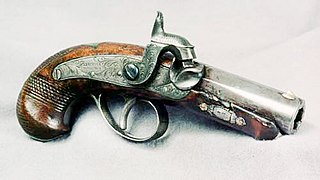
A carbine is a long gun that has a barrel shortened from its original length. Most modern carbines are rifles that are compact versions of a longer rifle or are rifles chambered for less powerful cartridges.

The Krag–Jørgensen is a repeating bolt-action rifle designed by the Norwegians Ole Herman Johannes Krag and Erik Jørgensen in the late 19th century. It was adopted as a standard arm by Norway, Denmark, and the United States. About 300 were delivered to Boer forces of the South African Republic.

Single-shot firearms are firearms that hold only a single round of ammunition, and must be reloaded manually after every shot. The history of firearms began with single-shot designs, then multi-barreled designs appeared, and eventually many centuries passed before multi-shot repeater designs became commonplace.

The Colt AR-15 is a lightweight, magazine-fed, gas-operated semi-automatic rifle. It is a semi-automatic version of the M16 rifle sold for the civilian and law enforcement markets in the United States. Colt's Manufacturing Company currently owns the AR-15 trademark, which is used exclusively for its line of semi-automatic AR-15 rifles.

In guns, particularly firearms, caliber is the specified nominal internal diameter of the gun barrel bore – regardless of how or where the bore is measured and whether the finished bore matches that specification. It is measured in inches or in millimeters. In the United States it is expressed in hundredths of an inch; in the United Kingdom in thousandths; and elsewhere in millimeters. For example, a "45 caliber" firearm has a barrel diameter of roughly 0.45 inches (11 mm). Barrel diameters can also be expressed using metric dimensions. For example, a "9 mm pistol" has a barrel diameter of about 9 millimeters. Since metric and US customary units do not convert evenly at this scale, metric conversions of caliber measured in decimal inches are typically approximations of the precise specifications in non-metric units, and vice versa.

The National Firearms Act (NFA), 73rd Congress, Sess. 2, ch. 757, 48 Stat. 1236 was enacted on June 26, 1934, and currently codified and amended as I.R.C. ch. 53. The law is an Act of Congress in the United States that, in general, imposes an excise tax on the manufacture and transfer of certain firearms and mandates the registration of those firearms. The NFA is also referred to as Title II of the federal firearms laws, with the Gun Control Act of 1968 ("GCA") as Title I.

Mauser, originally Königlich Württembergische Gewehrfabrik , is a German arms manufacturer. Their line of bolt-action rifles and semi-automatic pistols has been produced since the 1870s for the German armed forces. In the late 19th and early 20th centuries, Mauser designs were also exported and licensed to many countries which adopted them as military and civilian sporting firearms. The Mauser Model 98 in particular was widely adopted and copied, and is the foundation of many of today's sporting bolt-action rifles.

The long rifle, also known as longrifle, Kentucky rifle, Pennsylvania rifle, or American longrifle, was one of the first commonly used rifles for hunting and warfare. It is characterized by an unusually long barrel, a development in American rifles that was uncommon in European rifles of the same period.

The Browning Automatic Rifle (BAR) is a family of US automatic rifles and machine guns used by the United States and numerous other countries during the 20th century. The primary variant of the BAR series was the M1918, chambered for the .30-06 Springfield rifle cartridge and designed by John Browning in 1917 for the American Expeditionary Forces in Europe as a replacement for the French-made Chauchat and M1909 Benét–Mercié machine guns that US forces had previously been issued.

The M1903 Springfield, officially the United States Rifle, Caliber .30-06, Model 1903, is an American five-round magazine-fed, bolt-action service repeating rifle, used primarily during the first half of the 20th century.

A gunsmith is a person who repairs, modifies, designs, or builds guns. The occupation differs from an armorer, who usually replaces only worn parts in standard firearms. Gunsmiths do modifications and changes to a firearm that may require a very high level of craftsmanship, requiring the skills of a top-level machinist, a very skilled woodworker, and even an engineer. Gunsmiths perform factory-level repairs and renovations to restore a well-used or deteriorated firearms to new condition. They may make alterations to adapt sporting guns to better fit the individual shooter that may require extensive modifications to the firearm's stocks and metal parts. Repairs and redesigns may require fabrication and fitting of unavailable parts and assemblies constructed by smiths themselves. Gunsmiths may also renew metal finishes or apply decorative carvings or engravings to guns. Many gun shops offer gunsmithing service on the premises.

Henry Deringer was an American gunsmith. He is best known for inventing and giving his name to the derringer pistol.

Kerr's Patent Revolver was an unusual 5-shot single-action revolver manufactured from 1859 to 1866 by the London Armoury Company. It was used by Confederate cavalrymen during the U.S. Civil War. Seven of these revolvers were held by the New Zealand Colonial Defence Force in 1863 and were issued to the famous Forest Rangers at the start of the campaign to push Maori rebels out of the Auckland province. It is easily recognized by its side-mounted hammer.

The M1917 Enfield, the "American Enfield", formally named "United States Rifle, cal .30, Model of 1917" is an American modification and production of the .303-inch Pattern 1914 Enfield (P14) rifle, which was developed and manufactured during the period 1917–1918. Numerically, it was the main rifle used by the American Expeditionary Forces in Europe during World War I. The Danish Sirius Dog Sled Patrol on Greenland still use the M1917, which performs reliably in Arctic conditions, as their service weapon.
The Lorenz rifle was an Austrian rifle used in the mid 19th century. It was used in the Second Italian War of Independence in 1859 and the Austro-Prussian War in 1866, and also featured prominently in the American Civil War.
The Harper's Ferry M1803 rifle was the first standard rifle, made by an American armory.
The M1817 common rifle was a flintlock muzzle-loaded weapon issued due to the Dept. of Ordnance's order of 1814, produced by Henry Deringer and used from the 1820s to 1840s at the American frontier. Unlike the half octagon barreled M1814 common rifle that preceded it, it had a barrel that was round for most of its length. The 36-inch barrel was rifled for .54 caliber bullets. For rifling it had seven grooves. Like the M1814 common rifle, it had a large oval patch box in the stock, however the stock dropped steeper than on the M1814 common rifle.
The term Joslyn Rifle refers to a series of rifles produced in the mid-19th century. The term is often used to refer specifically to the Joslyn Model 1861/1862, which was the first mass-produced breech-loading rifle produced at the Springfield Armory.

The U.S. M1814 rifle was designed by Robert T. Wickham. The manufacturing was contracted out to Henry Deringer and R. Johnson to make rifles for use by the military.

An AR-15-style rifle is any lightweight semi-automatic rifle based on the Colt AR-15 design. The original ArmaLite AR-15 is a scaled-down derivative of Eugene Stoner's ArmaLite AR-10 design. The then Fairchild Engine and Airplane Corporation division ArmaLite sold the patent and trademarks to Colt's Manufacturing Company in 1959. After most of Colt's patents for the Colt AR-15 expired in 1977, many firearm manufacturers began to produce copies of the Colt AR-15 under various names. While the patents expired, Colt retained the trademark of the AR-15 and is the sole manufacturer able to label their firearms as AR-15. The "AR" in Colt AR-15 stands for "ArmaLite Rifle", not "assault rifle".
















